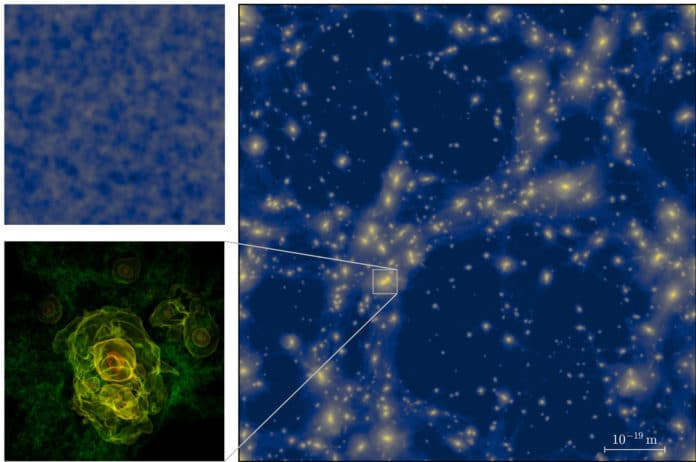Our Universe was born about 13.7 billion years ago in a massive expansion that blew space up like a gigantic balloon. This enormous expansion is known as Big Bang.
That is according to Big Bang theory, which virtually all cosmologists and theoretical physicists endorse. Although we can not observe the first moments of the Universe, it is possible to reconstruct it mathematically.
Physicists from the Universities of Göttingen and Auckland (New Zealand) have greatly improved the ability of complex computer simulations to describe the first moments of the Universe. Doing so, they found that a complex network of structures can form in the first trillionth of a second after the Big Bang. The behavior of these objects mimics the distribution of galaxies in today’s Universe.
Unlike today, be that as it may, these early-stage structures are microscopically small. Typical clumps have masses of a few grams and fit into volumes much smaller than present-day rudimentary particles.
The simulations also showed scientists the formation of regions with high density held together by their gravity.
Professor Jens Niemeyer, head of the Astrophysical Cosmology Group at the University of Göttingen, said, “The physical space represented by our simulation would fit into a single proton a million times over. It is probably the largest simulation of the smallest area of the Universe that has been carried out so far.”
Because of these simulations, scientists were able to quantify accurate predictions for these vestiges’ properties from the very beginnings of the Universe.
Benedikt Eggemeier, a Ph.D. student in Niemeyer’s group and first author of the study, said, “Although the computer-simulated structures would be very short-lived and eventually ‘vaporize’ into standard elementary particles, traces of this extreme early phase may be detectable in future experiments. The formation of such structures and their movements and interactions must have generated a background noise of gravitational waves. With the help of our simulations, we can calculate the strength of this gravitational wave signal, which might be measurable in the future.”
What about black holes/ How did they form?
Scientists offered the possibility that the complex network of structures might underwent runaway collapse, forming tiny black holes. If this happens, they could have observable consequences today or form part of the mysterious dark matter in the Universe.
Professor Esther said, “On the other hand, If the simulations predict black holes form, and we don’t see them, then we will have found a new way to test models of the infant Universe.”
Journal Reference:
- Benedikt Eggemeier et al, Formation of inflaton halos after inflation, Physical Review D (2021). DOI: 10.1103/PhysRevD.103.063525
